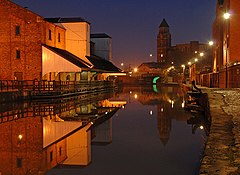Wigan, England
| Wigan | |
|---|---|
 Wigan Pier, a former wharf on the Leeds and Liverpool Canal |
|
| Wigan shown within Greater Manchester | |
| Population | 103,608 (2011 Census) |
| OS grid reference | SD583055 |
| • London | 176 miles (283 km) SE |
| Metropolitan borough | |
| Metropolitan county | |
| Region | |
| Country | England |
| Sovereign state | United Kingdom |
| Post town | WIGAN |
| Postcode district | WN1-WN3, WN5, WN6, WN8 |
| Dialling code | 01942 |
| Police | Greater Manchester |
| Fire | Greater Manchester |
| Ambulance | North West |
| EU Parliament | North West England |
| UK Parliament | |
Wigan /ˈwɪɡən/ is a town in Greater Manchester, England. It stands on the River Douglas, 7.9 miles (13 km) south-west of Bolton, 10 miles (16 km) north of Warrington and 16 miles (25.7 km) west-northwest of Manchester. Wigan is the largest settlement in the Metropolitan Borough of Wigan and is its administrative centre. The town of Wigan had a total population of 97,000 in 2011, whilst the wider borough has a population of 318,100.
Historically in Lancashire, Wigan during classical antiquity was in the territory of the Brigantes, an ancient Celtic tribe that ruled much of what is now northern England. The Brigantes were subjugated in the Roman conquest of Britain during the 1st century, and it is asserted that the Roman settlement of Coccium was established where Wigan lies. Wigan is believed to have been incorporated as a borough in 1246 following the issue of a charter by King Henry III of England. At the end of the Middle Ages it was one of four boroughs in Lancashire established by Royal charters; the others were Lancaster, Liverpool, and Preston.
...
Wikipedia

